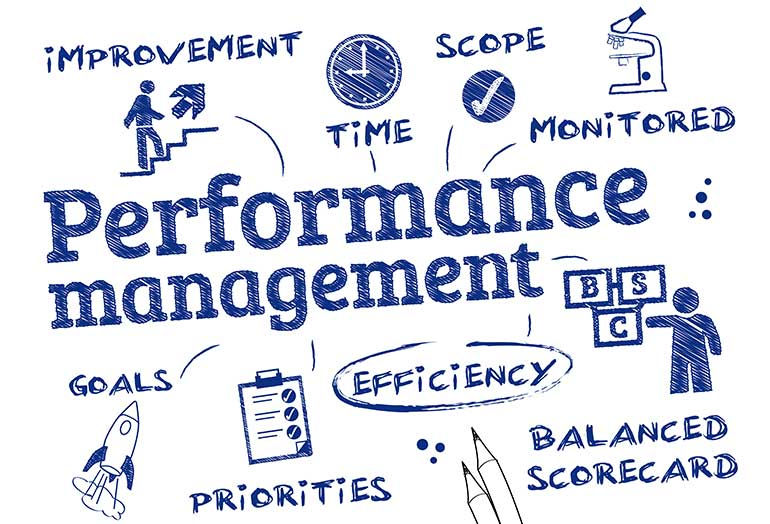Tools for Performance Measurement

Employers measure employee job performance through a variety of tools and processes. Some use more than one, but smaller businesses often choose one tool that works best for them and use it consistently. These systems of measurement, called performance appraisals, must come across as fair and just for employees to consider them credible.
Those implementing these tools should choose tools that offer the highest level of objectivity possible. Of course, removing all or most subjectivity is difficult, but some tools lend themselves to objectivity better than others.
Key Performance Indicators
Key performance indicators (KPIs) and metrics provide a way to measure how well companies, business units, projects or individuals are performing in relation to their strategic goals and objectives.
But the primary value of KPIs is not in measurement, but in enabling rich data-driven performance conversations and better decision making. Measuring everything that moves provides little more than an illusion that performance is being managed. Instead, it’s important to ask, “What goal will this KPI help my organisation achieve,or what problem will it resolve?” and “What decisions will the KPI help drive?”
Well-designed KPIs should be vital navigational instruments, giving a clear picture of current levels of performance and whether the business is where it needs to be.
Performance Appraisals
With 360-degree feedback performance appraisals, managers receive anonymous feedback from individuals with whom they interact frequently in the course of daily operations.
These can include internal and external customers, superiors, direct reports, subordinates, vendors, and salespeople. A human resources representative or outside consultant trains evaluators in the proper interpretation of multiple-choice survey questions and written responses. Evaluators are chosen at random from the above groups to avoid skewed results.
Managers often trust the responses from 360 feedback appraisals because of their confidential nature. This makes the responders feel free to give honest answers without fear of retribution.
360 Degree Feedback
With 360-degree feedback performance appraisals, managers receive anonymous feedback from individuals with whom they interact frequently in the course of daily operations.
These can include internal and external customers, superiors, direct reports, subordinates, vendors, and salespeople. A human resources representative or outside consultant trains evaluators in the proper interpretation of multiple-choice survey questions and written responses. Evaluators are chosen at random from the above groups to avoid skewed results.
Managers often trust the responses from 360 feedback appraisals because of their confidential nature. This makes the responders feel free to give honest answers without fear of retribution.
Balanced Scorecard
This approach combines quantifiable information, such as sales quotas and budgetary requirements, with performance standards, particular to the position. It utilizes key performance indicators, or KPIs, to track how well the employee has reached short and long-term goals.
These take into account the employee’s career growth and adherence to best practices as set forth by the individual organization. The balanced scorecard approach to performance measurement is most often utilized at the highest echelon of business, but middle management might use it as well.
Voted one of the most influential business ideas ever presented in the Harvard Business Review, the BSC has been massively popular over the last 20 years.
The BSC is a strategy execution tool that helps companies to:
- Clarify their strategy and communicate their business priorities and objectives;
- Monitor progress by measuring to what extent priorities and objectives are being delivered; and
- Define and manage action plans to ensure initiatives are in place to deliver the business’s priorities and strategic objectives.
Management by Objective
With this method, managers meet with direct reports and, together, come up with short and long-term goals for the year that are in line with the company’s key objectives and business mission. At year-end, the managers measure their employees’ achievements against these goals.
Peter Drucker coined the term, “management by objective,” in the 1950s when the business world worked quite differently than today. He suggested inflexible, static goals and objectives for the employees, but in today’s high-tech world, fluid and dynamic goals work best.
By allowing for periodic tweaking of the original goals, many companies can still effectively utilize this model for performance measurement.
Personal Development Plans (PDP)
A Performance development plan or PDP is effectively a tailored action plan that is based on reflection and awareness of an individual’s performance and needs, setting out goals for future performance and actions that will support personal development.
PDPs are often used to identify specific training and development needs and create an action plan for meeting those needs (for example, through specific courses or shadowing other employees). It helps individuals set out how they want to grow, and what actions they can take to achieve that growth. This not only helps the individual feel more invested in the company, and the role they play in its success, it also identifies concrete steps that can help drive individual performance in the future.
Investing in or developing performance management tools, techniques and processes like these, is an important part of creating a culture of high performance. And that’s exactly what every business, regardless of size, in every industry, should be aiming for – strong performance at every single level of the organisation.
Self Evaluation
Self-evaluation tools allow the employee to rate himself against the same or similar criteria used by his supervisor. Often this involves qualitative and quantitative criteria.
Self-evaluation method can raise the credibility level of the process in the view of the employee; especially when the employee’s self-assessment score lines up closely with that of the supervisor. When the scores are somewhat at odds with one another, this tool offers discussion processes whereby these differences can be discussed in a safe and constructive manner.

